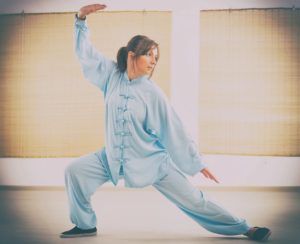 The Chinese martial arts are widely believed to have traveled with the first Buddhist monks who arrived from India. The monks practiced these arts to protect themselves and their monasteries from bandits. From China these arts then travelled through to Japan, where they were further modified. Chinese arts like Wing Chun tend to emphasise the line of attack and the centre line of the body which is also common in most martial arts. Folklore tells us that different regions developed different styles to suit the terrain, e.g. hilly regions tended not to use kicking techniques. Monks also developed arts based on animals that they saw, giving rise to names such as “Praying Mantis”, “White Crane” and “Monkey” style, there is even a “Drunken Man” style. Bruce Lee, a famous student of Wing Chun master Yip Man, went on to develop his own style called Jeet Kune Do (his books feature some Aikido techniques as well). There is quite lot of Kungfu in Sydney
The Chinese martial arts are widely believed to have traveled with the first Buddhist monks who arrived from India. The monks practiced these arts to protect themselves and their monasteries from bandits. From China these arts then travelled through to Japan, where they were further modified. Chinese arts like Wing Chun tend to emphasise the line of attack and the centre line of the body which is also common in most martial arts. Folklore tells us that different regions developed different styles to suit the terrain, e.g. hilly regions tended not to use kicking techniques. Monks also developed arts based on animals that they saw, giving rise to names such as “Praying Mantis”, “White Crane” and “Monkey” style, there is even a “Drunken Man” style. Bruce Lee, a famous student of Wing Chun master Yip Man, went on to develop his own style called Jeet Kune Do (his books feature some Aikido techniques as well). There is quite lot of Kungfu in Sydney
Many of the movements in Aikido show remarkable similarity to many of the Chinese arts. There do seem to be modifications though, as the roots of Aikido are in battlefield combat where armour was worn by opponents and razor sharp swords were used. Thus many blocking techniques employed in other arts aren’t used in Aikido. The founder of Aikido is understood to have travelled China extensively, which may also have compounded the similarities.
